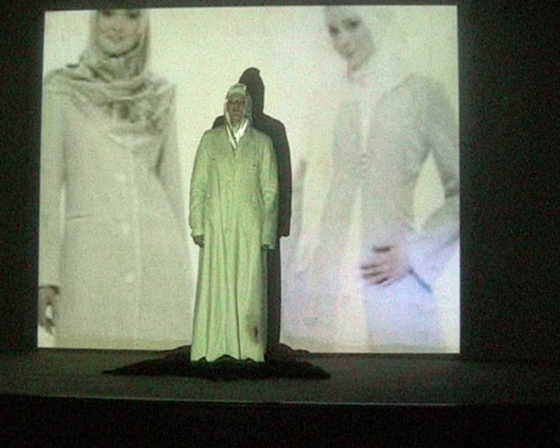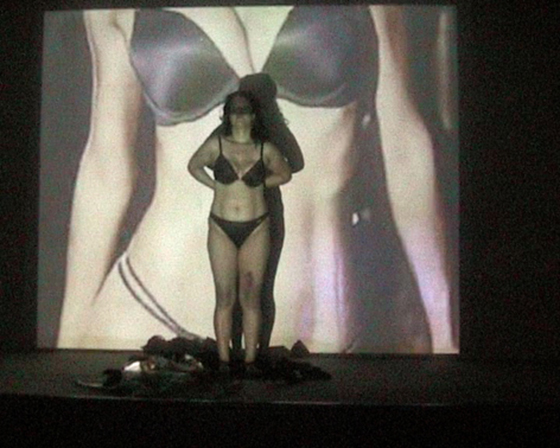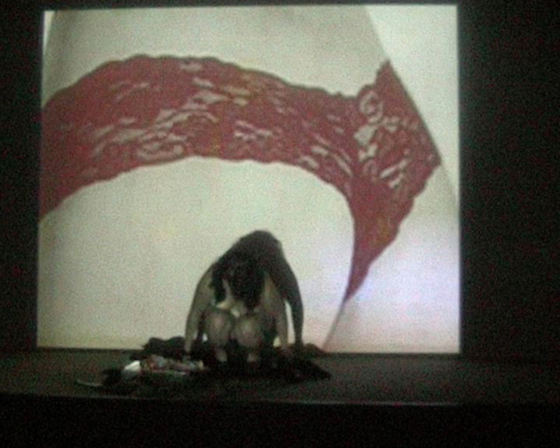Bashfulness (2007)
Hicap
Performance
5 min.









“Hicap” (Bashfulness), “Emine & Mine,” and finally “Ayak Sesleri” (Sound of Footsteps) are nourished by the same source. All of them are created by using the relations between social sexuality, social power and the control of the body, as the foundation. These three works that were completed consecutively, point out the concepts with a wide range from politics to East-West dilemma, from economy to the fashion of covering your body.
“Sound of Footsteps”(2004) makes a referral to Islamic references about the covering of the body. The practice of Islamic covering is based on the principle to make the women invisible and to prevent her from getting attention in the public places. However, surprisingly, the style of clothing that is used to veil the body has surfaced from the need of veiled women to appear like the other woman and to have a place in the public places.
The year that I have completed this work, 2004, was also the time when the headscarf discussions that have political basis are started to be discussed and became a part of the political agenda in Turkey. I think that, the veiled women who are detained in the private areas, started to make their footsteps heard, primarily by getting into the public places with their veiled clothing style.
“Sound of Footsteps”(2004) consists of 100 headscarves that were fashionable at the time they were produced. Clusters of real hair from both veiled and not veiled women’s heads were added to the fringes of each piece. Little bells that were sewn on them make a loud noise when the wind blows.
Later, veiled women in the fields increased their voices even more, because of the discussions about the prohibition of wearing headscarves in universities and government offices. With this process, women became the instrument of the secular and anti-secular discussions in Turkey. Political arguments that are based on the clothing and the image of “women” are brought up by both sides.
Actually this was nothing new. With the foundation of the republic, even in earlier times, Turkish westernization, evaluated the setting in order of the image, above all, and evolved in this way. This “setting in order” was generally made on the clothing of women. This policy about women body, continued without any interruption. It was some kind of an image democracy. It is nourished by the same channels with “image conservatism”.
“Emine & Mine” (2007) was produced at a time when these arguments heated up. At one side, the founder of Turkish Republic Atatürk’s wife Latife’s adoption of the western style of clothing and leaving her veil aside was being discussed. On the other side, current president of republic’s wife’s choice about wearing a headscarf or not has become an important factor in the political arena. Two types of women profile are created.
However, the “sexist oppression” that is hidden behind the cover of “modernism” or “belief”, by the secular and anti-secular groups, was always felt (deep inside) by the women who were divided into two groups.
“Bashfulness” (2007); this video performance was also produced during the same period. The word “Hicap” is originated from Arabic. In Turkish it means, to be ashamed of, shyness, bashfulness. In Iran, “Hicap” means getting covered.
When the discussion that is created in the western nations about the Islamic way of dressing is taken into account, the condition of being eastern materializes with the image of woman who is “repressed” and has “no identity”, and then transforms into a symbol with “headscarf”, “burqa” or “chador”. Yet, this multilayered image democracy or conservatism will not hesitate to use the image of woman without making a difference in-between chador, headscarf, ensemble or underwear, both in the east and the west, in a wide range of ways from economy to politics.
Canan Senol